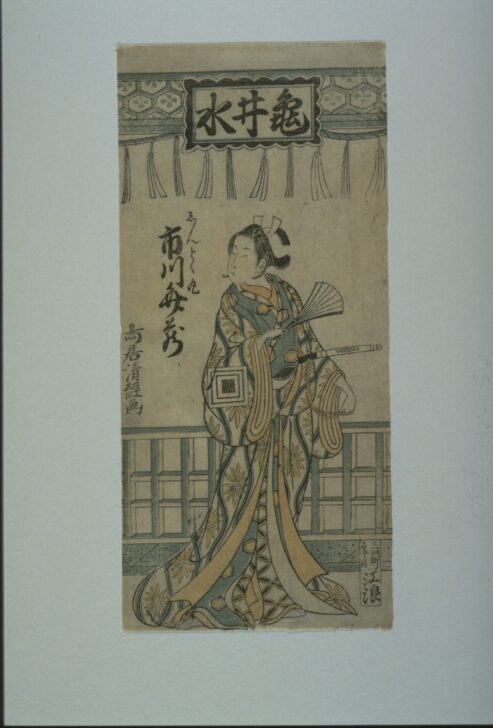Ichikawa Benzō I as Shintokumaru
Torii Kiyotsune

Description
In this pin-up print of the Kabuki actor Ichikawa Benzō, he appears in the role of a swashbuckling hero (note the sword) who is in temporary disguise as a young maiden of high class. With a mincing walk, a coy turn of the head, and an ever-so-elegant gesture with his fan, he convincingly inhabits his adopted female character standing on the balcony of a shrine with the tablet above his head reading "Kame-i mizu" (Turtle-Well Water). This performance took place at the Nakamura-za in 1768.
Kabuki was the popular theatre of Edo-period Japan. From the 1640s to the present, women have been banned from the stage, so female roles are played by male actors. An actor’s ability to be a female impersonator was not determined by body type or attractiveness; what mattered was the ability to create a feminine persona. Costume and make-up were part of the artifice, but bodily movement and the voice were the crucial elements. Japanese theatre-goers readily accepted the idea that gender is "constructed," rather than something physically innate—because on the kabuki stage, all aspects of character were artificial constructs.
The technique seen here is an example of early experiments toward multiple-block printing. Three blocks (for black, green, and pink) were used to make this print.
M. Graybill
"Courtesans, Cross-Dressers, and the Girl Next Door Images of the Feminine in Japanese Popular Prints"
3/9 - 9/1/02
Exhibited in "Japanese Costumes & Ceramics, Past & Present," October 2001-February 2002. Maribeth Graybill, Senior Curator of Asian Art
Subject Matter:
The Ichikawa line of actors is among the oldest kabuki lineages, founded by Ichikawa Danjūrō in the 1660s. They are known for specializing in a wide variety of role types. There is little information available on Benzō, so it is unclear whether or not he is a part of the Ichikawa line of actors.
Physical Description:
A man dressed as a woman stands under a blue and white fringed drape that reads Kamei no mizu. The man is wearing a orange, blue, and black multi-layered robe with floral bursts on the outer layer. He carries a sword in his belt and holds an open fan in his right hand. His hair is tied back with a white ribbon. He is standing in front of a fence or lattice.
Inscriptions: Ichikawa Benzō, Shintokumaru; Mikawachō [?] chō me, Enami (Publisher's seal); Torii Kiyotsune (Signature)
Usage Rights:
If you are interested in using an image for a publication, please visit https://umma.umich.edu/request-image/ for more information and to fill out the online Image Rights and Reproductions Request Form.